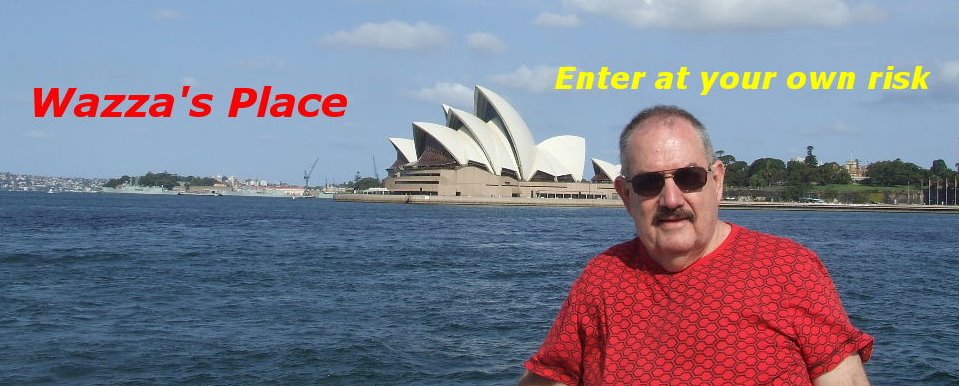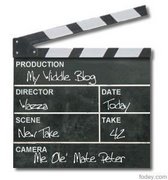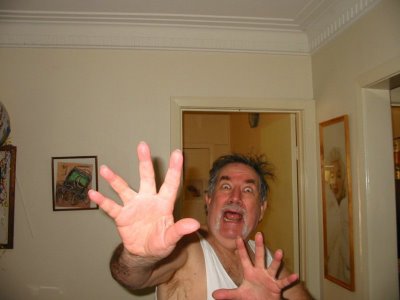Brisbane to Perth with Holtie Part 9
This was a great photo I found on the net while researching
stories for this post. It shows a mob of emus crossing the road.
(Double click the photo to enlarge it)

Leaving Geraldton we headed south to the Pinnacles and
suddenly told Peter to stop the car. I had noticed a Echidna
running across the road. Jumping out of the car we saw the
Echidna scramble into the nearby scrub. I was able to get
some video as the Spiny Ant Eater disappeared out of sight.
The Echidna (or Spiny Ant-eater) and the Platypus share the
distinction of being the only two mammals that lay eggs.
Echidnas are widely distributed throughout
live in a variety of habitats, from dry deserts to humid rain
forests or in the
porcupine but are not related. Echidnas grow up to 50cm in
length. The spiny ant-eater has remarkable defensive ability
when it feels threatened. It rolls itself into a ball, with it's
prickly spines out to protect its soft under-parts, and can
dig itself into sand or earth with great speed.
Two hours later and 180km south of Geraldton we drove off
the main highway and turned onto the dirt road that took us
into the
The
Park
best known landscapes.
area of 17491 ha. Here, thousands of huge limestone pillars
rise from the shifting yellow sands. They are all shapes and
sizes, some are jagged, sharp-edged columns, rising to a
point, while others resemble tombstones. The raw material
for the limestone of the Pinnacles came from sea shells rich in
marine life. These shells were broken down into lime rich
sands which were brought ashore by waves and then carried
inland by the wind to form high, mobile dunes.
......................Peter at the Pinnacles.
The
late 1960s, when the Department of Lands and Surveys
agreed to add the area to the already existing National park,
which had been established in 1956. Today the park is visited
by approximately 200,000 visitors each year from
and all over the world.
The Pinnacles are considered one of natural wonders of
(The Olgas), The
Leaving the Pinnacles we now only had 245km to
where we were going to stay with one of Peter’s sons.
As we drove further south I noticed a lot of small round
melons growing along the side of the road and there were
hundreds more growing wild in paddocks we were passing.
I asked Peter to stop so I could have a closer look at these
melons. I had never seen so many growing wild in one area.
Peter told me that these were Paddy Melons.
The paddy melon is a prostrate or climbing annual herb native
to southern
striped fruit; the fruit and foliage are toxic. The plant has
been known to kill livestock. The melon is a weed in
and
melon, bitter apple, and gooseberry gourd.
The paddy melon was introduced as camel fodder, and has
exploded in areas of disturbance. The melons are a favourite
of the pink cockatoo.
Getting out of the car I asked Peter if he had a knife as I wanted to open one of the melons to see what it looked like inside and to maybe taste one of them. He pulled a small pocket knife out of his pocket. Looking at the knife I said “That’s not a knife” and drawing the huge bowie knife out of the sheath on my belt I said “Now that’s a knife” I then opened the melon. Inside it looked like a watermelon, white seeds only with a light green coloured flesh. I asked Peter if your could eat these and he told me that they were not to be eaten as they were poison to cattle.
I wiped a small amount of juice onto my finger to taste the melon.
It was very bitter.
............Crocodile Wazza...."Now that's a Knife.
We drove into
Later that evening all the family drove over to Marcus’s
(one of Peter’s sons and he also has his own blog
“Holt Press 2”) place for a family get together and have
dinner. The next day was Mother’s Day so all the Holtie
gang were meeting up at
That evening we slept in a real bed after a few weeks of
“roughing” it in a tent.
Australia
largest city in
of the state's residents.
The first documented European sighting of the region was made by the Dutch Captain Willem de Vlamingh and his crew on
Captain James Stirling, aboard the Parmelia, reached
Swan River named after the Black Swans......Downtown Perth on the Swan River.
The
On the
as a public park by the Commissioner for Lands, Sir Malcolm
Fraser. The area was renamed Kings Park in 1901 in honour
of King Edward VII after a visit to Perth by his son, the Duke
of York (later King George V).


Banksia ................and a Morning Iris
The total area of the Park is 406 hectares (roughly 1,000
acres) and is located adjacent to the
approximately 1.5 km from the CBD of
thirds of the Park is natural bushland containing 319 species
of native plants and around 80 bird species.
Pink Fairy Orchid and Lechenaultia.
In September each year the Wildflower Festival is held in
it’s well worth the effort to visit to see the huge range of
wildflowers that are on display.
Carboprotis and Royal Mulla Mulla.
Silky Blue Orchid and Scarlet Feather Flower.
..........................................Melaleuca
Most likely the first visitor to the
Frederick de Houtman on
ships
first reached the Western Australian coast near
Willem de Vlamingh in 1697, after the famous black swans
of the area. Vlamingh sailed with a small party up the river
to around
Nicholas Baudin also sailed up the river in 1801.
.....Wazza overlooking the Swan River from Kings Park.
After a few days visiting with Peter’s three sons and having
a look around Perth we now set off for the South West area
to one of the best wine producing areas in W.A., Margaret
River, then Albany and finally Beverley and small town about
130km south east of Perth where we were going to stay with
friends of Peters for a couple of days. All this and more will be
revealed in Part 10, the final chapter or is it???



























